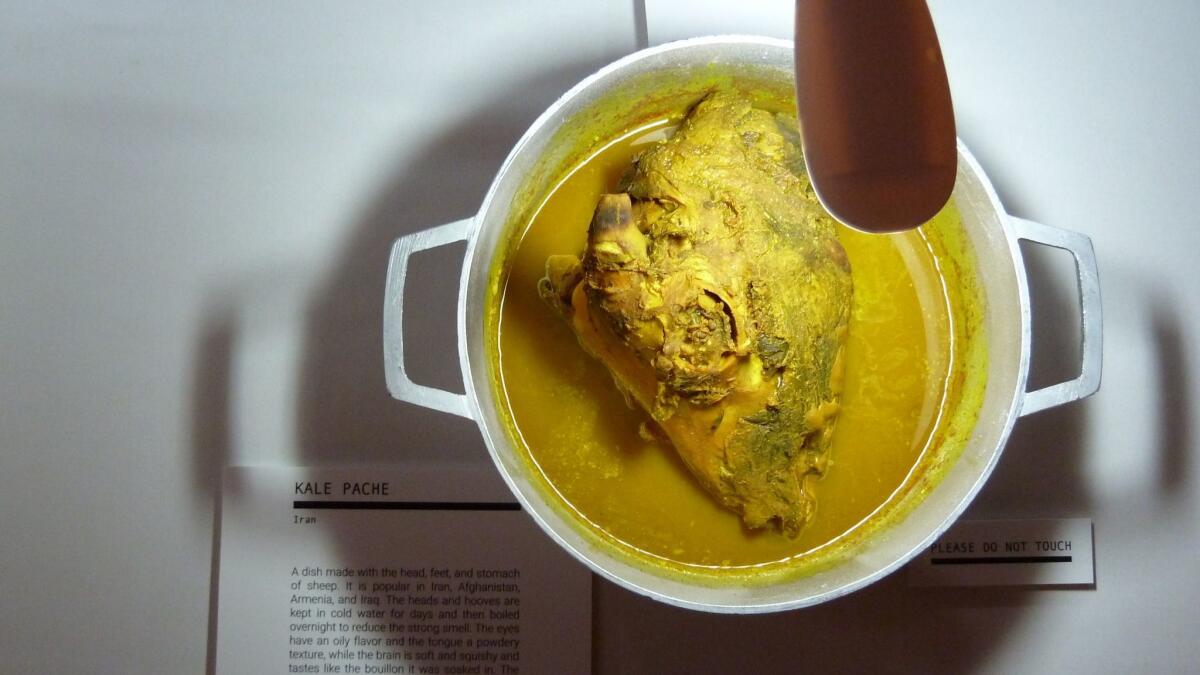The Disgusting Food Museum aims to challenge ideas of what we find gross, but reinforces cultural prejudices

Your ticket to the Disgusting Food Museum is a barf bag, like you’d see tucked into the back of an airplane seat. That should tell you much of what you need to know about this museum, a contrivance of Swedish psychologist Samuel West, who brought us the moderately amusing Museum of Failure in 2017 — another pop-up menagerie that highlighted unsuccessful innovations like Crystal Pepsi and Google Glass.
But while a museum of failed products can unify us common folk in a mockery of marketing missteps and corporate soullessness, a museum of foods designated as “disgusting” — including fermented soybeans from Japan and corn smut from Mexico — doesn’t offer much to the world.
The museum, which debuted in Malmo, Sweden, in October and is in residence at the Architecture and Design Museum in downtown Los Angeles until February, purports to be an in-depth look into the psychological nature of disgust — but it comes across as little more than a slapped-together, somewhat cynical attempt to capitalize on popular food culture. And there’s an unfortunate side effect to your ticket: It helps reinforce the uneven power structures that exist within the decidedly white, Eurocentric view of cuisine that already prevails here.
Pop-up museums have become, for better or worse, a fixture of our landscape over the last several years — see the Museum of Ice Cream, Museum of Pizza and the Museum of Selfies, the latter of which could almost be a brilliantly meta, self-referential art project if it didn’t cost $25 to get in (tickets to the Disgusting Food Museum are $15 Wednesday through Friday and $18 on weekends). They’re Instagram fodder pretending to be something more informative; selfie opportunities masquerading as cultural institutions. Ultimately, they’re there to make money.
And there’s absolutely nothing wrong with that — especially when the self-described museum punches up to skewer those in power, as in the case of the Museum of Failure. But the problems with the Disgusting Food Museum begin with its name: Why should anyone get to decide which foods are disgusting and which aren’t? The word “disgusting” is strongly pejorative, and the feeling of disgust is individual. It’s personal — I, for example, find hard-boiled eggs unpalatable.
West knows this — at the entrance to his museum, he acknowledges in a written exposition, “Disgust is cultural. We like the foods we have grown up with” and that the concept of disgust can change over time. “Two hundred years ago, lobster was so undesirable that it was only fed to prisoners and slaves,” he writes. “Today, lobster is a delicious luxury.” He then lists several categories of disgust, including “moral,” “sexual” and “mutilation-deformity.”
What’s not acknowledged, however, are existing prejudices in this country, and around the world, against certain foods — specifically, against the foods of certain immigrant cultures. The stereotypes are so worn and commonplace as to be played for laughs, but they very much persist: It’s an age-old trope that Asian cultures serve food that’s “dirty” or “weird.”

It’s a stereotype that I and others were subjected to growing up Asian American, leading to longstanding feelings of shame associated with certain foods and ingredients. Traditional Chinese food is “gross” (leading to the evolution of sticky-sweet citrus- or military-themed chicken dishes Americans have come to love). Smelly or slimy European foods, by contrast — strong cheeses or foie gras (displayed in the museum) — were largely seen as delicacies, or a mark of wealth and sophistication. The playing field, in other words, has never been level.
West doesn’t view it that way. He rejected the notion that the museum contributes to any existing stereotypes or prejudices about certain cultures’ foods: “Absolutely not,” he said during a chat at the end of my visit. “We look at stinky tofu through the same lens that we look at European foods.”
But the lens of the museum is fairly narrow, and confined to one large room. The different foods, 80 or so of them, are laid out on long, flat tables, grouped very generally by region. Sometimes the actual food is there, like with the strong-smelling durian fruit. Sometimes it’s not, like with the big, red plastic model shown in the lobster section. There’s a desk lamp throwing a harsh light onto each example, as well as a small bit of text. The exhibit looks quickly thrown together, especially with displays like root beer, where a lonely can of A&W is just plopped onto the table, or Pop-Tarts, where a few boxes of the sugary pastry sit there, unadorned.
Root beer and Pop-Tarts as disgusting? Well, the United States had to be included, somehow. Asia is the most represented region of the world, and China is the most represented country, with 11 entries. The Chinese examples — dog meat, rabbit heads and bull penis — are unevenly lumped together. Dog meat is controversial within China, a country with more than 1.4 billion people, a majority of whom I can confidently assert do not eat dog meat (in Hong Kong and Taiwan, it’s illegal). Rabbit heads, on the other hand, are a specialty of the Sichuan region, and I saw them frequently in Chengdu during a recent trip. Penis is consumed for medicinal or aphrodisiacal purposes — not as a common meal. “The variation alone in China could have filled a good part of the museum,” West said in a follow-up interview, but added that he “really tried not to single out a single group.”
Nuance is, unsurprisingly, what is lacking at the Disgusting Food Museum. Mexican menudo — a commonly eaten (and delicious!) tripe soup — is trotted out along with a lurid sheep’s eyeball floating in tomato juice, which may or may not be a Mongolian hangover cure. Countries and cuisines are treated as monoliths — even the U.S., illustrated through Pop-Tarts, Twinkies and soda in a nod to stereotypes about obesity and poor eating habits, isn’t let off the hook. And that, perhaps, is where the museum ultimately fails: It oversimplifies, it’s clichéd, and it all just seems a little bit mean.
West concedes that his use of the word “disgusting” is meant to provoke, to some degree. But when the word “museum” is used in the same breath, there’s an implied authority and permanence. It seems like the museum is trying to have it both ways — poking the bear, then backing away, hands raised innocently. “As with any kind of book or art, I think I know what I’m trying to communicate, what I want to communicate,” he said. “But people take home messages I can’t control.”
Toward the back of the exhibit is a counter where patrons can try different foods — Polish sok z kiszonej kapusty (sauerkraut juice) or hakarl, fermented Icelandic shark. A young couple stepped up to try the shark and West eagerly reached for the young woman’s cellphone, wanting to record the moment they bit into the rotten shark. When they did, chewed and swallowed without so much as wincing, his face fell with disappointment.
Near the entrance, just past the $20 hats and $25 aprons for sale, is the Wall of Disgust, where patrons can write down on slips of paper what disgusts them, and stick them to the wall with magnets. When I looked, not many foods were listed. “Loud chewing,” read one slip. “Capitalism,” read another.
There was one slip, though, that really resonated: “Nothing is disgusting! Duh!” I couldn’t have put it better myself.
A+D Architecture and Design Museum, 900 E. 4th St., Los Angeles, disgustingfoodmuseum.com/losangeles.
More to Read
Eat your way across L.A.
Get our weekly Tasting Notes newsletter for reviews, news and more.
You may occasionally receive promotional content from the Los Angeles Times.











